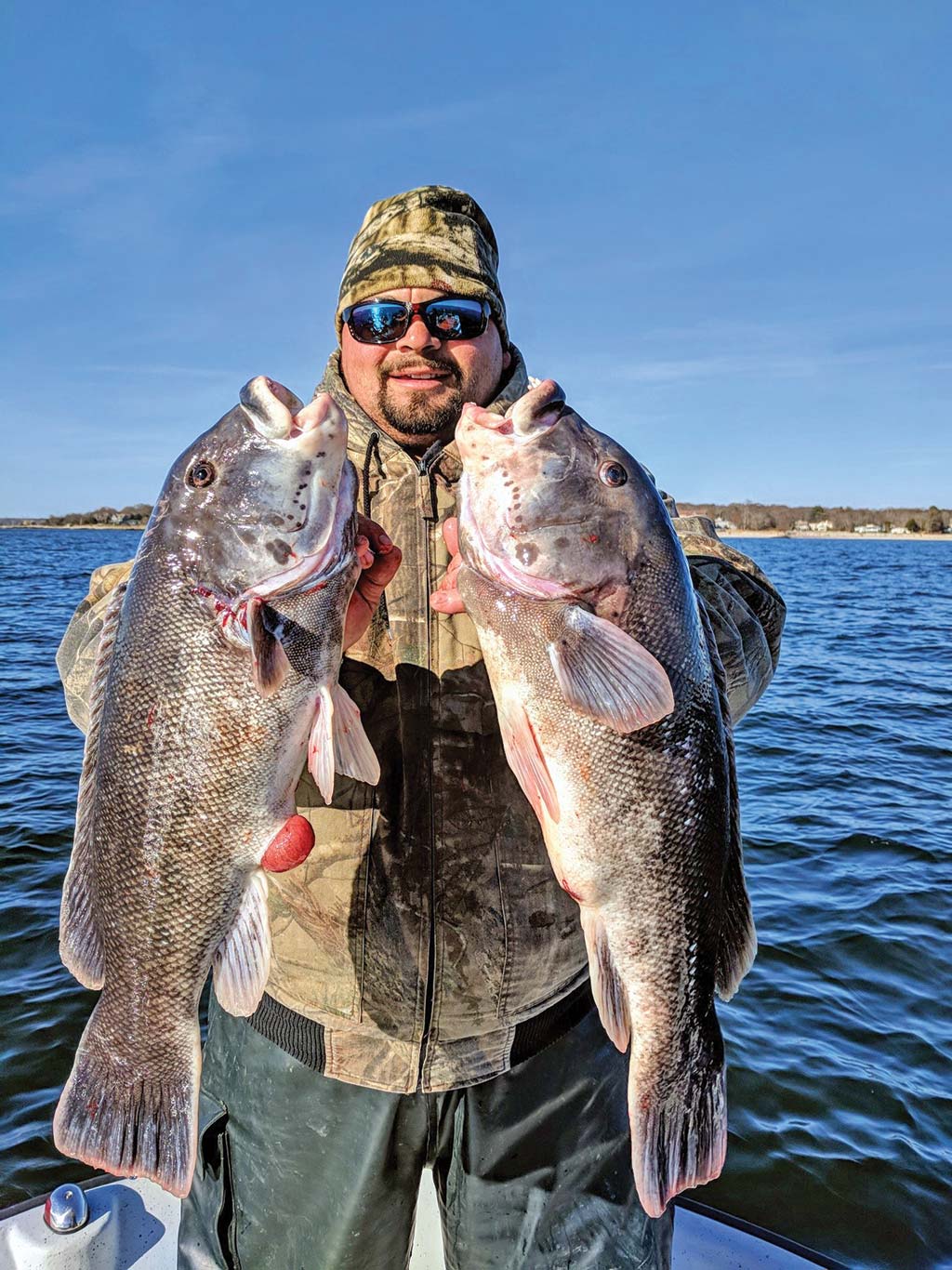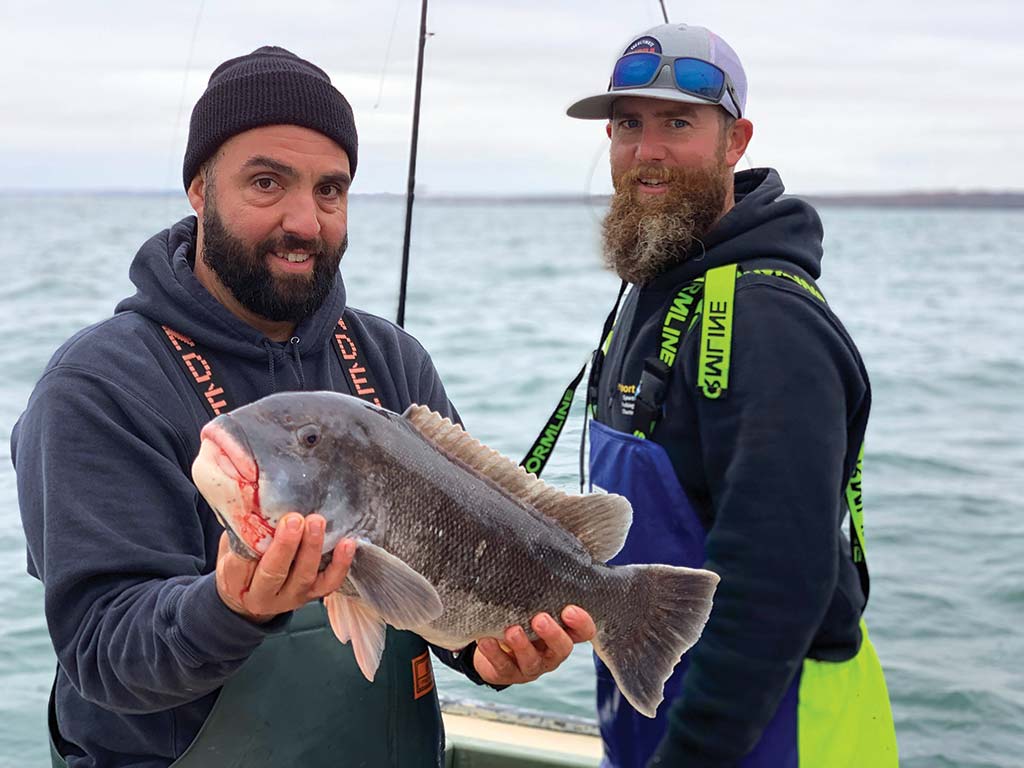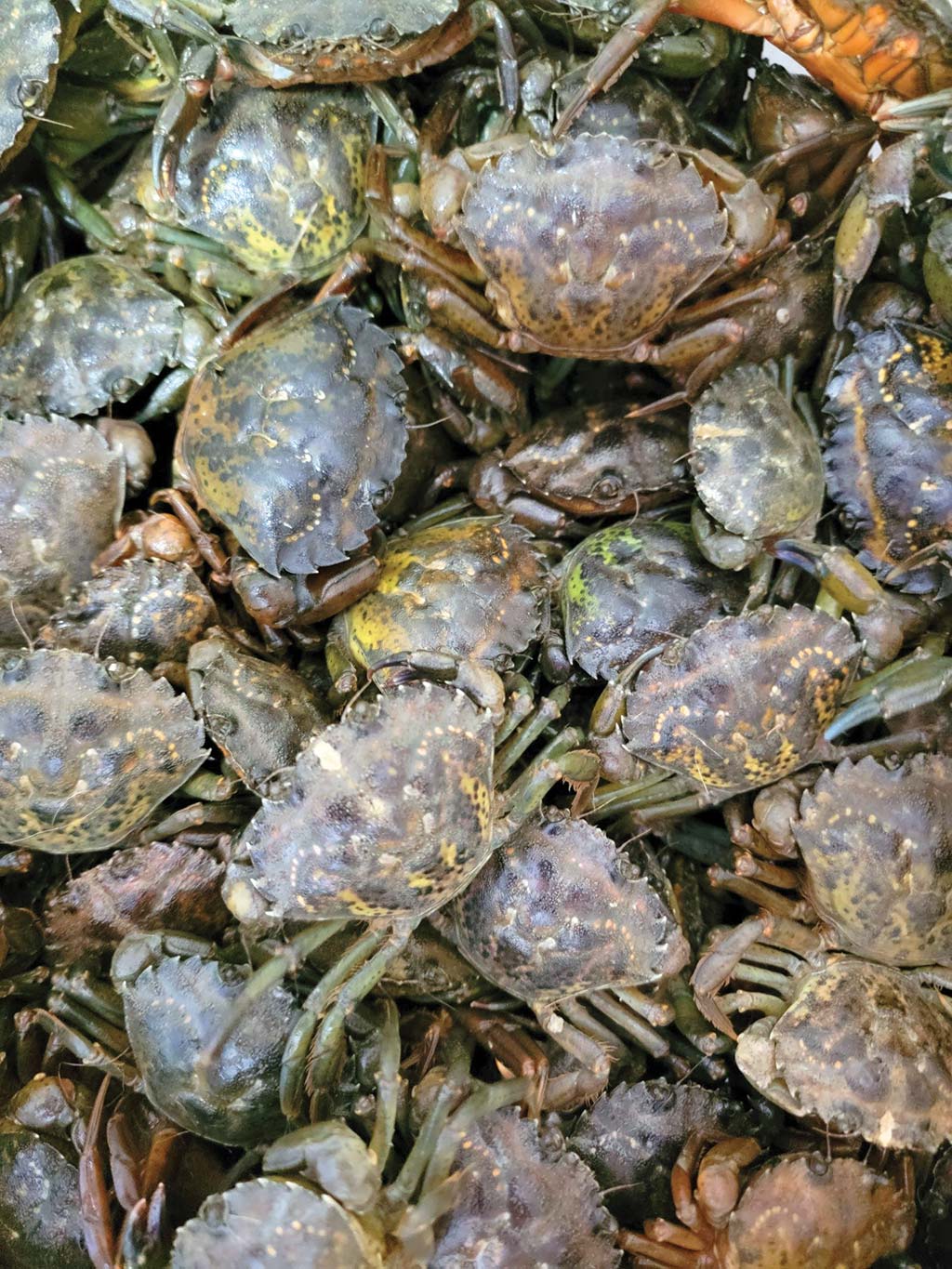
Three top-shelf toggers talk about blackfishing beyond Thanksgiving.
The blackfish is sort of the unsung hero of the New England inshore fishing scene. For a long, long time these leather-lipped bottom-dwellers with a face only a mother could love, were misunderstood. They were thought of—only as—a meat fish, and the equipment that was used for togging was akin to using a block and tackle to load a cargo ship. Mid-sized conventional reels, clamped onto short and stout rods, the only goal being to winch them off the bottom and put more meat on the deck. Or perhaps this is how the fishery was portrayed for last several decades—maybe the hardcores were making it seem like work because it was so much fun.
For the last 12 years, or so, I penned the Connecticut Coast Report in this magazine, and I was continually struck by the anticipation felt by Connecticut anglers as the early October opener would draw near. Tackle shops throughout the state would encourage anglers to order their crabs early, and those that didn’t were often left running to multiple shops the morning of the season’s start, trying to put enough crabs in the bucket for a day’s fishing. I would say that the blackfish opener was rivaled only by the trout opener in the spring, but what the tog opener might lack in sheer numbers of lines in the water, it crushes the ‘Opening Day’ tradition in the intensity of the anglers that make it a tradition. Dale Nicholson, Advertising Sales Manager for The Fisherman, told me, “A couple buddies and I have made a tradition out of it, we never miss the opener! I order a bushel of crabs from J&B Tackle ahead of time and we’re ready to go right at sunup. Some years we’ve stayed out almost all day, because it’s such a great time of year to be out on the Sound.”
It’s clear that many Connecticut anglers get fired up for the opener, but there’s no less enthusiasm in Rhode Island or Massachusetts waters, despite the fact that tautog are in play for all of September in both states. But no matter which of the three southern New England states you reside or fish in, October gets all the press as the best of the best for fall togging and November is often thought of as a ‘last gasp’ for the hopeless tog addicts that can’t be satiated and are feeling the pressure of the season’s end, looming in the not-so-distant future.

Halloween & Beyond
“I’ll be honest with you,” said Andrew Nichols owner of Fishin’ Factory 3 in Middletown, CT, “I don’t even want to fish for blackfish until November, I still go in October, but I don’t get really serious until November.” Wise words from a guy who not only loves to fish for tog, but also really knows the local fishery well. In my conversations with anglers all over New England there is a strong divide about whether November togging is even worth it, but from what I’ve seen, written about, and especially after conducting the interviews for this story, I think the guys that say it’s not worth it have made their minds up ahead of time. It could be the call of the tree stand, it could be that they don’t like to get chilly (poor babies) or maybe they move onto something else, whatever it is, saying it’s not worth it is nothing more than an attempt to convince themselves that choosing not to go is the right decision.
Capt. Rob Taylor: Learn to fish a slack line if you want to catch big ones. Green crabs don’t drink Red Bull, meaning, they aren’t jumping three feet up into the water column every five seconds as the waves pass overhead. Keeping some slack in the line will keep your jig or rig on the bottom. You have to learn to watch the line and feel for a bite though, because sometimes you will only see the line jump. It will cost you some crabs in the beginning, but once you get it down, you’ll start catching bigger fish.
Andrew Nichols: If you don’t have Spot Lock on your boat then you’ll need to master the art of anchoring on structure. Being off by even a few feet can be the difference between crushing fish and killing time. Also, don’t be afraid to go really deep in November, a good bite can die off overnight if a good cold snap blows through, that’s when you have to move deeper and you may have to hit 90 feet or more by the time the season closes.
Capt. Jason Colby: There are thousands and thousands of spots that look like they should hold fish along the coast of southern New England, but not all of them actually do. The key to finding the ones that produce is finding life. Drive over or around the spot and watch the screen for marks, if you’re marking small fish, other species of fish or even what appears to be just a few blackfish, you’ve found a potentially productive spot. When you set up to fish it, give it time, the sound of fish chewing your bait and the scent given off will draw in nearby blackfish. Spots that support one kind of marine life, tend to support them all.
“I love those icy mornings in November!” said Capt. Rob Taylor from Newport Sportfishing Charters, “a hard north blow, 20 mph or more, with some good moving water, it really gets them chewing. I tend to fish a little deeper somewhere between 35 and 90 feet, and I like to fish over depth transitions until I can dial in where they’re setting up.” Capt. Rob also said that he loves November because there are fewer ‘bait stealers’ around as most of the sea bass and scup have moved out. All three of the anglers I polled say they move deeper in November, but the depths are far from absolute. Capt. Rob – as you read above – will fish as deep as 90 feet while Colby says he rarely goes deeper than 60. “Long Island Sound is different than places like Newport,” added Andrew Nichols, “I rarely have to fish deeper than 30 feet, but if I do feel like I have to fish really deep, I like to target wrecks first.”
“I like stability in the weather,” said Capt. Jason Colby of Little Sister Charters, “I don’t particularly care what direction the wind is blowing, but when we’ve had three days of consistent winds from the same direction, I know we’re going to do well.” This is another case proving the saying I’m very fond of, “fish are fish”. In other words, you can take your findings from one species and usually apply it (loosely) to another and find that it works. In striper fishing a good bite will last a lot longer if the conditions stay, more or less, the same, but when the wind changes or the seas go from rough to calm or calm to rough, the fish move on. In the case of togging, the fish probably don’t move but they may scatter in their attempts to find the best places to set up for the new conditions at hand.
Making November Count
It’s funny how seemingly minute changes can send the fish deeper. A strong cold snap was cited by Andrew and Capt. Rob as a trigger for the togs to start moving deeper. “Basically, I know I have to move out of the shallows when the water dips below 55”, Andrew told me, “but even if you see a drop of two degrees overnight, those fish might move.” Sometimes though, a move to deeper water just isn’t feasible. “I let the conditions tell me when and where to fish.” Said Capt. Colby, “If we’re dealing with hard north winds, I’m not heading way offshore to beat my clients up in big seas. I’ve found that there are always some stragglers in shallower water and we can fish on those and stay in the lee of the land. We might not get an easy limit, but we usually get there and many of these of inshore stragglers are nice-sized fish.”
The eleventh month is also a great time to hunt for a big one. “By far, we hook more double-digit togs in November than any other month.” Said Capt. Rob, “If I want a big one I will ditch the jigs and fish with snafu rigs. We’ve done well with white crabs in deep water when looking for big ones, but greens work well too. You have to up your patience level when you’re hunting for a big one, don’t set on every chew, let those crabs soak until you feel the big thump!” Out in Long Island Sound you can rely on the tide to up your odds of hooking bigger fish. “Inside Long Island Sound,” Andrew added, “we catch more and bigger fish on flood tides. Sure, you can catch them anytime, but the flood seems to consistently produce better action and bigger fish.”

Fishing In Flux
“Something I always say,” added Captain Rob at the end of our conversation, “Is that there are no ‘hard and fast’ rules in fishing. I tend to move deeper in November, but some years I haven’t had to move out until the second half of the month.” This fact dovetails pretty well with the advice of all of these guys, the most successful anglers are always flexible in their planning. If the fish demonstrate that they are still in 20 feet, stay on them. If you’re only getting shorts, move deeper. If you’re not seeing signs of life, try a new spot. If you’re on a favorite piece of bottom and it’s not producing, try it at a different stage of the tide; try slack, try peak current.
Tautog are a slow-growing fish that most experts believe to be territorial. Tagging studies are still in their infancy, but I do know of a fish tagged in Rhode Island that was recaptured nearly 25 miles away in Buzzards Bay a year later. It takes a double-digit fish about 20 years to reach that size and the largest fish can live as long as 35 years. It takes both male and female blackfish four years to reach reproductive size and age, and they reach the 16-inch minimum size at age 8. All three of the expert anglers polled advocate releasing the big females. “Those are old fish and they can produce a ton of eggs,” said Jason Colby, “I definitely strongly suggest releasing the big ones, but I do realize that it’s not always easy for anglers to turn their personal best loose.”
And definitely don’t assign boundaries to the season. I think we’ve effectively stamped out any smoldering doubts about the viability of the November blackfish bite in New England, but don’t assume that season is going to come to a fast end either. I asked all three of these experts if the tog typically stop biting at a certain point. Andrew said he can catch them consistently on the last day of the season in Connecticut. Colby said he wraps up his charter season around mid-month and always leaves them biting. Capt. Rob said, “I catch them well into December.” And when I told him that that the Rhode Island season was set to close on December 31st this year he smiled and said, “They’ll still bite.”




